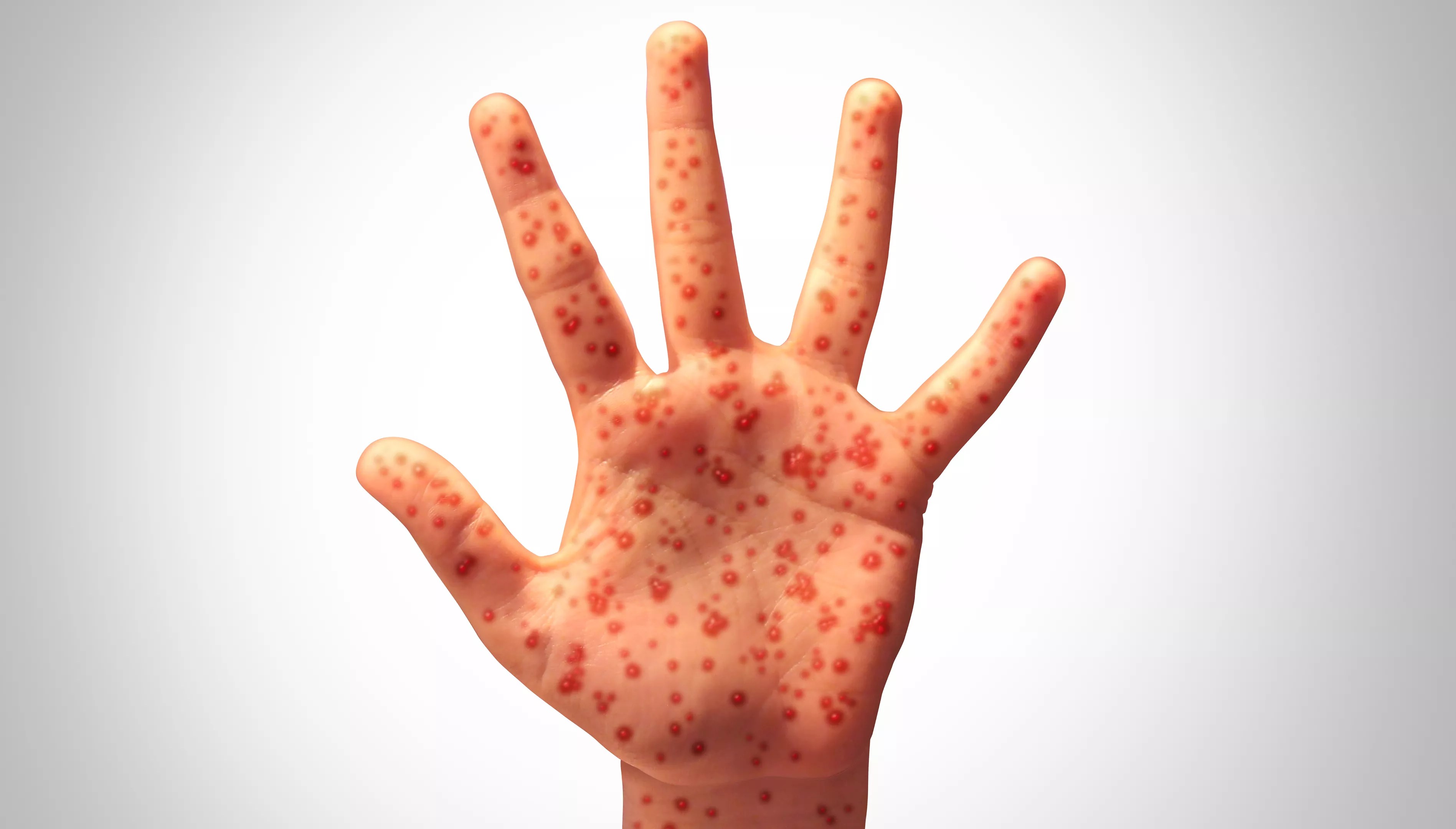
wildpixel/Getty Images

Audio By Carbonatix
Janeth Ibarra didn’t know what to do.
She was a first-time mom at 22 years old, and now the Phoenix resident was responsible for protecting two twin boys from the harms of the world. New parents drink from a firehose of child-rearing suggestions – mommy blogs and car seat reviews, feeding tutorials and daycare ratings – but after her boys were born last year, Ibarra was especially tortured about one big decision.
Whether to vaccinate her babies.
The world is awash in vaccine misinformation, and it’s no wonder if new parents like Ibarra have a hard time discerning which way is up. The anti-vax trend started in 1998, when The Lancet published a widely debunked study linking childhood vaccines to autism – the publication retracted it, though anti-vax proponents often fail to mention that – and went into overdrive during the COVID-19 pandemic.
Will you step up to support New Times this year?
At New Times, we’re small and scrappy — and we make the most of every dollar from our supporters. Right now, we’re $15,500 away from reaching our December 31 goal of $30,000. If you’ve ever learned something new, stayed informed, or felt more connected because of New Times, now’s the time to give back.
Once consigned to the fringes of society, the anti-vax movement is now depressingly mainstream. Robert F. Kennedy Jr., perhaps the single biggest purveyor of vaccine misinformation on the planet, runs the Department of Health and Human Services. Under his leadership, the department has axed crucial funding that helps state and local governments promote vaccine awareness and respond to outbreaks of disease.
At the same time, the country is suffering through its biggest measles outbreak in decades. The super-contagious disease – once considered eradicated by, you guessed it, vaccines – has popped up in 29 states as of May 2. At least 935 measles cases have been reported nationally since January. The disease, which is especially deadly to young children, has already killed three people, including two young children. They were the first measles deaths in the U.S. since 2015.
So far, Arizona has been spared a measles case. But Arizona’s vaccination rate is low. When it comes to measles, a vaccination rate of 95% is considered enough to ensure herd immunity, giving the disease nowhere to spread. But in Arizona, only 89.3% of kindergartners have received both doses of the vaccine against measles, mumps and rubella. In some communities, the rate is far lower.
It’s in the middle of a cyclone of conflicting information – Are vaccines life-savers? Mortal threats? – that Ibarra found herself in her pediatrician’s office. She had begun to “reconsider some vaccines,” she said, and needed help plotting a course through the fog. Pediatricians are veterans of these talks. Ibarra says hers patiently told her “the facts of things” and promised to “inform me of the correct things instead of what I see on the internet.”
Ibarra decided to vaccinate her kids. Though her 10-month-old boys are too young for the first dose of the MMR vaccine – the first dose comes at one year, the second at four – she’ll get them vaxxed against measles when the time comes.
“Vaccines are important,” Ibarra said. “They are very important to me, especially for my kids to have.”
Until then, though, her children are vulnerable. One of the fictions of the “vaccines are a personal choice” movement is that when it comes to diseases like measles, they’re really not. Measles kills the youngest among us, and those very same young cannot be fully immunized until they’re on the cusp of grade school. When a community has herd immunity and measles cannot spread, those children face little danger. When a community dips below that – as Arizona has – measles can attack the kids of even the most pro-vax parents.
For the next two months, until her kids can receive the first dose of the MMR vaccine, Ibarra will be on guard. Though Arizona hasn’t had a case yet, measles is surely coming. State and county public health departments have been bracing for it, but they have a hand tied behind their backs. In Gaines County, Texas – where the outbreak began, leading to at least 390 cases in the county – the MMR vaccine rate is 82%. In some corners of Arizona, the vaccine rate is lower. And RFK Jr.’s department just slashed funds for vaccine campaigns and epidemic preparedness.
An outbreak “will happen,” said Dr. Clarisa Smith, a pediatrician in Yavapai County. “I think that’s inevitable.”
Is Arizona ready?
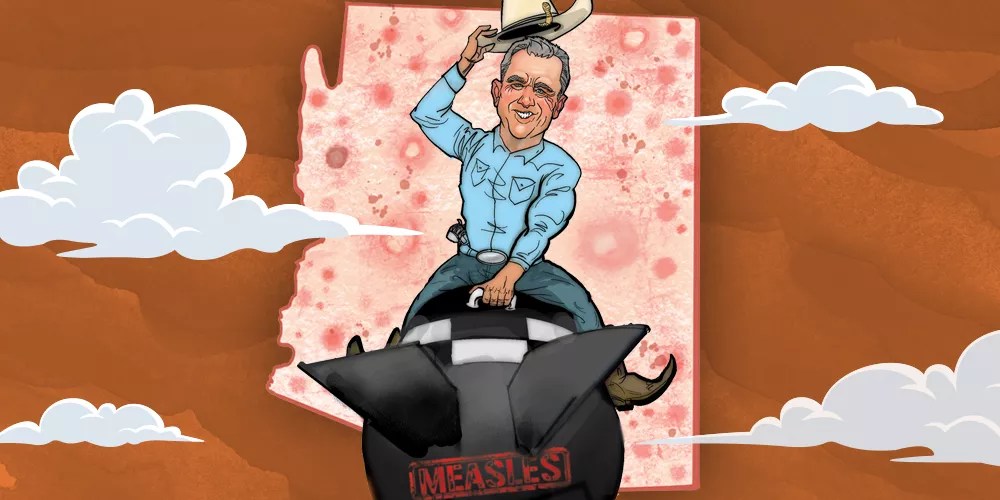
Health and Human Services Secretary Robert F. Kennedy Jr., who visited the Arizona Capitol last month, is arguably the single biggest spreader of vaccine misinformation on the planet.
New Times Illustration
A powder keg
Long before it was controversial, the MMR vaccine was tantamount to a miracle.
Until it was developed in the late 1960s, measles outbreaks were a fact of life in the United States. Measles is one of the most contagious diseases on earth. One person infected with COVID-19 can spread it to roughly three susceptible people. Someone with measles can infect up to 10, a difference with geometric consequences for the potential spread. For some, the disease is mild – a rash, a fever, a cough and a runny nose. But according to the Centers for Disease Control and Prevention, 20% of unvaccinated people end up in the hospital. Many of those will get pneumonia, and some will die.
A serious measles case is a grim thing to see. If a child contracts measles – especially an unvaccinated child – they are increasingly susceptible to life-threatening complications. Kids who start with a nasty rash and cough can quickly find themselves gasping for air and being hooked up to a ventilator. Skin becomes pale. Due to a lack of oxygen, lips and fingertips turn blueish-gray. Some children will recover, but others won’t. Instead, their parents will sit beside their hospital beds, holding their child’s small hand as they slip in and out of consciousness. Maybe that beloved son or daughter will stay awake long enough to hear a last goodbye. In the end, the child’s muscles give in. Their chest falls. It does not rise again.
In 1962, before the measles vaccine was licensed, there were 500,000 measles cases in the United States. Roughly 400-500 people died each year, about 1,000 suffered brain swelling and 48,000 required hospitalization. In 1990, when a second measles vaccine dose was recommended, there were fewer than 100,000 cases a year in the country. By 2000, the disease was considered eliminated.
But who doesn’t love a comeback story? This millennium, measles cases have become more common. There were 667 cases in 2014 and 1,274 cases in 2019. This year, the country is on pace for roughly 2,800 cases, which would be the most since 1992. For generations of kids, measles presented no threat. Now it’s on the hunt again.
The biggest reason for that is maddeningly simple. More and more parents decided not to give their kids the shots that confer 97% protection against one of the most contagious diseases in the world. Arizona is among the laggards.
According to the Arizona Department of Health Services, only 89.3% of Arizona kindergartners were fully vaccinated against measles during the 2023-24 school year – less than required for herd immunity, but not terrible. However, some areas of the state are more protected than others. Only two Arizona counties – Yuma and Santa Cruz – reached herd immunity, with central county Pinal falling just short at 94%.
In Yavapai and Mohave counties, herd immunity is basically a fantasy. Only 79.4% of kindergartners are vaccinated against measles in Mohave County. Yavapai County’s rate is a state-worst 77.9%. “You’ve got this whole giant cohort in these parts of the state where we have really susceptible kids,” said Will Humble, the executive director of the nonprofit Arizona Public Health Association. In other words, parts of the state are a powder keg.
“If it does happen in our community, I anticipate a fairly large outbreak,” said Smith, who owns Yavapai Pediatrics. “It’ll be a lot like that county in Texas.”
If parents would get their kids vaxxed, none of this would be a concern. But as Smith knows, the anti-vax current is strong. Every day at her practice in Prescott Valley, she talks to new parents about vaccines. She reassures and presents the facts. “There’s a good portion of parents that just want more information,” she said. Another cohort cannot be convinced. Those parents “are very adamant that, ‘I’m not comfortable with it,” Smith said. Because she requires all her patients to be vaccinated, those parents have to find another pediatrician.
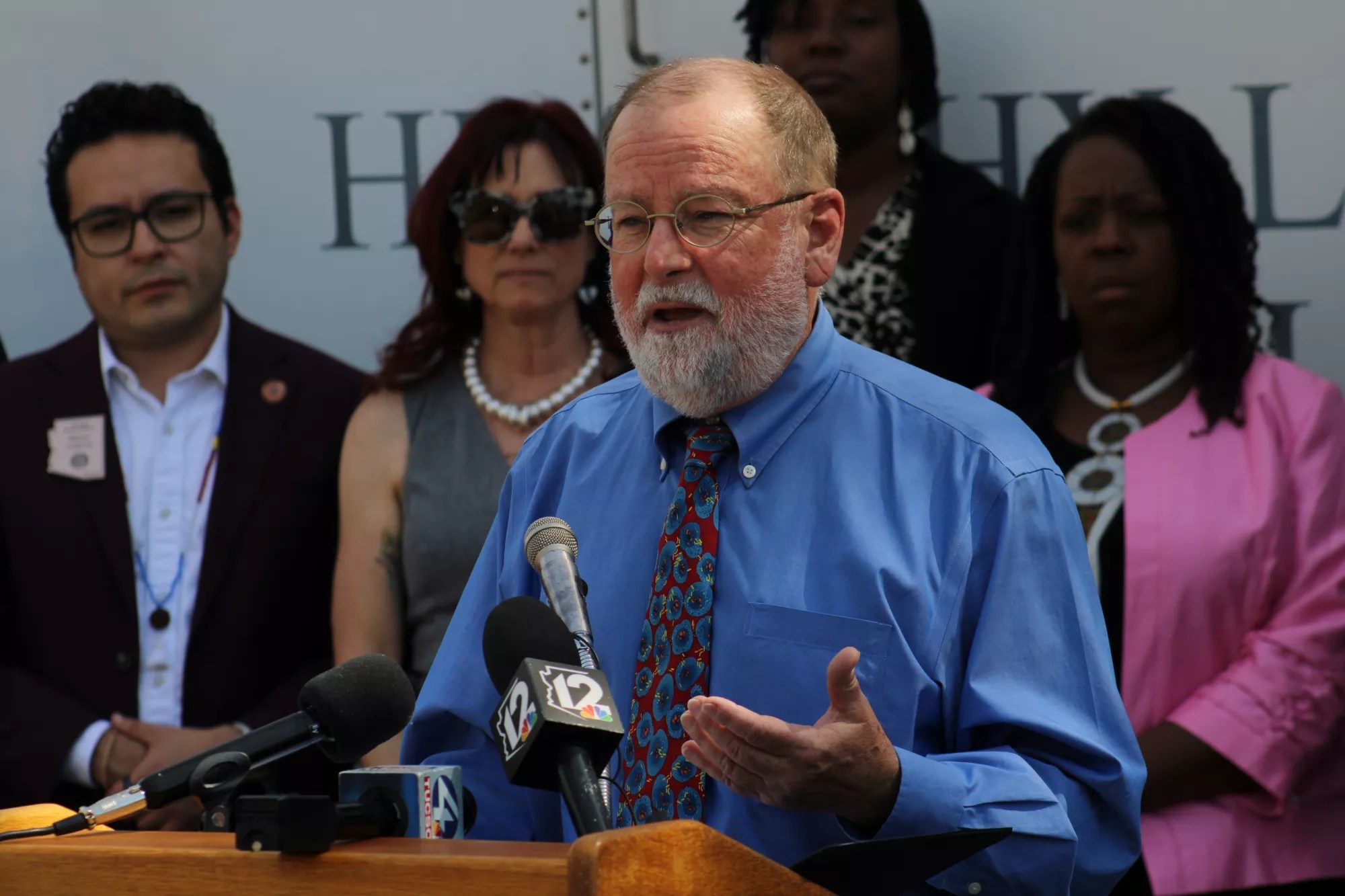
Will Humble, the executive director of the Arizona Public Health Association.
Morgan Fischer
Why are vaccine rates so low? There’s the epidemic of misinformation – the bunk science RFK Jr. promotes is nearly as contagious as measles – but there’s also the fact that generations of kids have grown up without having to worry about measles at all. Because many parents haven’t seen the firsthand effects of a measles outbreak, they tend to underestimate how deadly one could be.
“It seems like we think that things happen to other people and not to us,” said Dr. Kathy Krieg, a pediatrician based in Gilbert. “We have this magical thinking that because we haven’t died of this before, therefore if it hasn’t personally happened to us, it’s not going to happen to us.”
People don’t always do what’s best for them, which is why your mom made you eat your vegetables. But in Arizona and many other states, no authority figure is lording over the table to say, “No dessert until you vaccinate your child.” Especially since the COVID-19 pandemic, when many conservatives rebelled against mask mandates and vaccine requirements, flying the banner of personal choice has been an avenue to political power.
Lawmakers in Arizona and beyond have won office spouting conspiracy theories about COVID-19 and about vaccines at large. Gov. Katie Hobbs, a Democrat, has already vetoed four anti-vax bills this year. Last month, when RFK Jr. visited the Arizona Legislature to promote a healthy-food bill, reporters were cut off and booed when they audaciously asked him – the man in charge of the nation’s health care infrastructure – about the country’s largest measles outbreak in decades.
“People who aren’t vaccinating their kids aren’t just doing that and being quiet about it,” said Ashley Chambers, the executive director of Arizona Families for Vaccines. “They’re trying to convince other people not to vaccinate their kids, and they’re trying to influence our lawmakers to enact policy that supports anti-vaccine people and their opinions.”
As a result, Arizona has lax vaccine laws. Many states require up-to-date vaccines to attend public school, insisting upon medical documentation and granting exemptions only for religious reasons. But in Arizona, all that stands between a parent and sending their unvaccinated child to public school is a two-page form. ARS 15-873 allows parents to submit a signed statement to a school administrator outlining that “due to personal beliefs,” they “do not consent to the immunization of the pupil.” It’s as simple as checking a few boxes.
When it’s that easy to get out of vaccinating your kids, low-information parents or those who aren’t already pro-vaccine are all the more likely to let it fall by the wayside. “You get a lot more parents who say that they don’t want their children to be vaccinated because it’s easy,” said Kelly Murphy, a coordinator at the Arizona Early Childhood Alliance. “If you don’t make it easy for people to opt out, then they won’t.”
Though Arizona’s exemption has existed for decades, long before COVID-19 hit, exemptions have skyrocketed since then, according to Axios. Last year, 8.5% of kindergartners had vaccine exemptions, which Chambers said leaves the state “absolutely ripe for a measles outbreak.” What’s more, vaccination rates tend to follow a pattern depending on the type of school.
If an unvaccinated student in a Maricopa County public school classroom catches a case of measles, “there’s a pretty good chance that every other kid in that homeroom, at least, is vaccinated, and it’s not going to spin out of control,” Humble said. However, the vaccine exemption rate in Arizona’s charter schools is 6.6%, nearly double the rate at public schools. At private schools, it’s 10.7% – nearly triple.
If there’s a measles outbreak, don’t be surprised if it starts at a private school. “It’s much easier to get a cascade of cases at a charter or private school,” said Humble, “than it is at a public.”
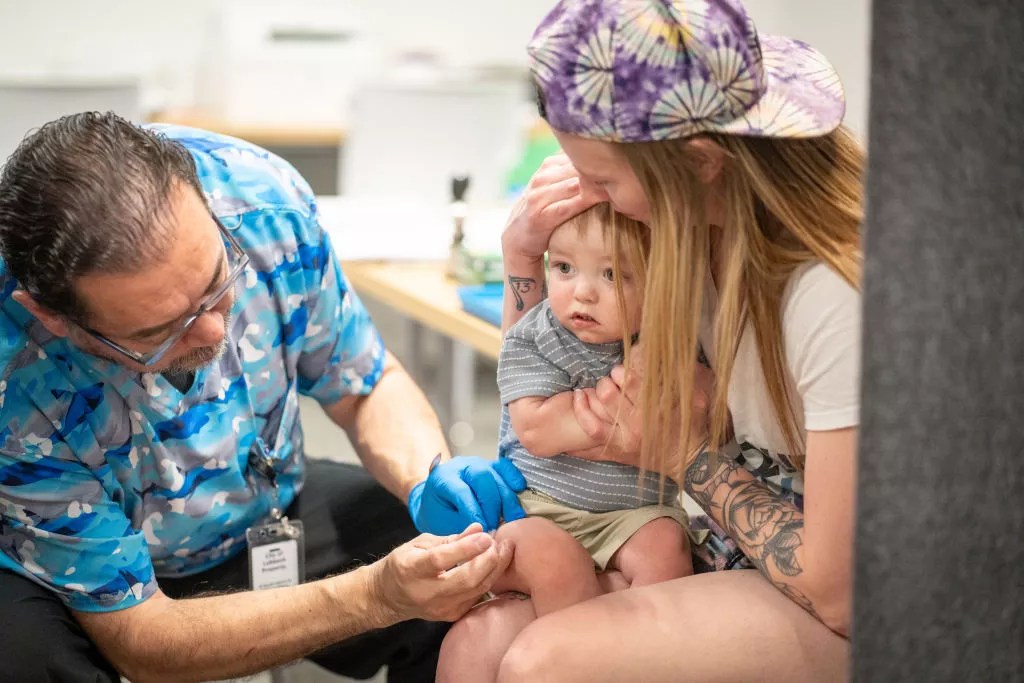
Measles can be particularly dangerous to young, unvaccinated children.
Jan Sonnenmair/Getty Images
When an outbreak happens
Measles hasn’t been a stranger to Arizona in recent years. But it’s no snowbird, buckling down for an extended stay – it has popped in briefly, then disappeared.
In 2024, Maricopa County had two cases and Yavapai County had one. In September 2022, three related measles cases were confirmed in unvaccinated people in Maricopa County, and one person required hospitalization. A 1-year-old was also diagnosed with measles in Pima County in 2019.
The next outbreak may not be so contained. But health officials have had plenty of practice. Nicole Witt, the assistant director of preparedness for the Arizona Department of Health Services, said Arizona “prepares for a measles outbreak every day.”
When a measles case pops up, here’s what happens.
If a child comes into a hospital’s emergency room or physician’s office with a rash, fever or measles-like symptoms, doctors and hospital staff immediately isolate the patient and contact their county’s health department. Next, an on-call epidemiologist with the county asks a series of questions about symptoms and testing. The county health department facilitates testing through the state, reaching an ADHS epidemiologist via an online form. A courier picks up a sample – generally a urine sample or nose swab – and drives it to an ADHS lab in Phoenix for testing. Depending on travel time, results are back in four to eight hours.
Since the Texas outbreak started, Maricopa County’s public health department “decreased the index of suspicion” for measles cases, meaning they’re testing more suspected cases than they would otherwise. Dr. Nick Staab, the chief medical officer for the Maricopa County Department of Public Health, said the department is testing 10-20 cases per week. None has come back positive. Yet.
In the meantime, county health departments begin to mobilize their incident command teams, which Witt called “the boots on the ground.” ADHS provides resources in support, but counties run the show. For larger counties like Pima and Maricopa, a team works to treat infected people and contain further spread. In Pima, emergency planners, trained to respond to disasters, coordinate with a 15-person public health team that includes epidemiologists and clinicians. Staff from other departments are reassigned to bolster the department’s response.
“It’s not one person on the phone trying to figure out if there was a positive case. We have a system on standby to be activated,” said Dr. Andrew Saal, the assistant medical director at the Pima County Health Department. “It’s all hands on deck. That’s how serious measles is.”
Epidemiologists launch an investigation to trace the infected person’s whereabouts over the previous four days and determine who else might have been exposed. Clinicians administer MMR vaccines to exposed people within 72 hours of their exposure, which can help prevent serious health effects. People in high-risk groups – such as infants, pregnant women and immunocompromised people – may receive immune globulin within six days of their exposure.
County health departments also issue public service announcements in the form of physical posters, community events and online posts. These advertise the communicable disease hotline, which residents can call if they come across a suspected case. It also tells them where they can get vaccinated in the county and what families can do to protect themselves.
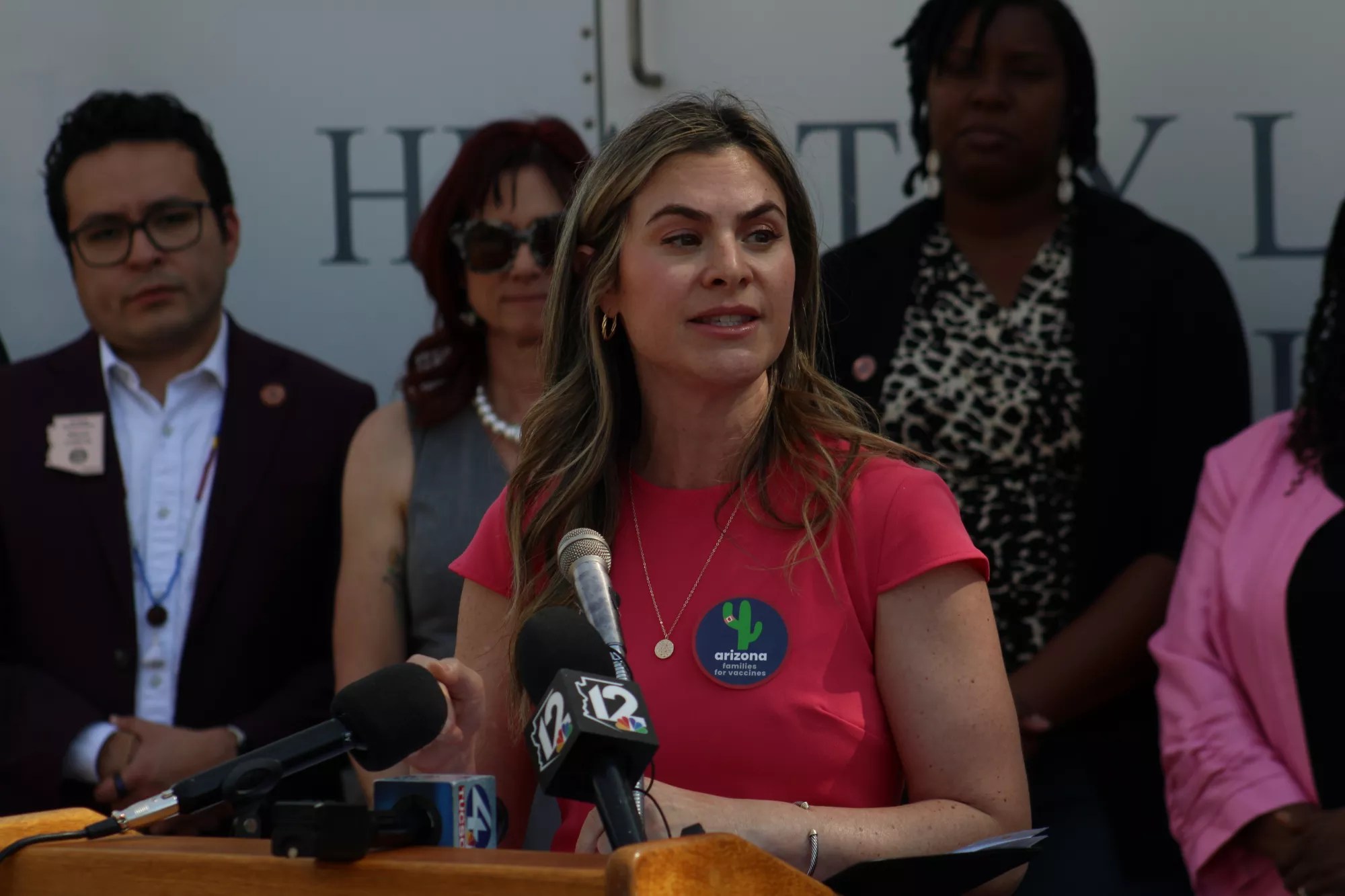
“People who aren’t vaccinating their kids aren’t just doing that and being quiet about it,” said Ashley Chambers, the executive director of Arizona Families for Vaccines. “They’re trying to convince other people not to vaccinate their kids.”
Morgan Fischer
Smaller counties like Gila County rely more on community partners, such as nurses, school administrators, hospitals and community health centers. Their resources are fewer. But both large and small county health departments have been prepped not only by past measles cases but also by having recently battled, you know, the worst pandemic in 100 years.
“COVID really prepared us, to be honest with you,” said Savannah Barajas, an epidemiologist at the Gila County Health Department.
The west Texas outbreak has accelerated those preparations. Since that explosion of cases, Pima County’s team has met every Friday for a month to get ready for a measles outbreak in their backyard. They’ve also been ramping up communication with community partners and updating messaging. Gila County has been running tabletop exercises to prepare while also upping vaccine communication with residents.
In one sense, the Texas outbreak is doing half the work for them. “Since the outbreaks have been publicized, we are getting more people coming in to get vaccines,” Barajas said. An ounce of prevention is worth a pound of cure, as the saying goes, and the measles vaccine is mighty preventative.
“Vaccines are highly, highly effective for this particular condition,” Saal said. “No one should ever lose their child to a condition that is fully preventable.”
While health officials feel prepared, they’re arguably not as prepared as they were six months ago. In late March, the federal government cut nearly $240 million of Arizona’s public health funding, cutting into grants for epidemiology and vaccines for children that were funneled to all 15 county health departments. Mohave County eliminated the positions of two health navigators and one communicable disease investigator, both of whom would help the county contain an outbreak. Two public health nurse positions were eliminated in Yavapai County. Maricopa County has had to scale back its mobile clinics, which helped to provide vaccines to uninsured people, those with disabilities and folks who live in rural areas.
The upshot is this: Arizona has fewer resources to get kids vaccinated against measles, and fewer resources to contain an outbreak if one occurs, especially in rural areas. County health officials who spoke to Phoenix New Times for this story all expressed their confidence in their ability to respond to a measles outbreak, but it will also require doing the same job with less money.
“Any time that budget cuts result in our loss of staff, that does affect our ability to respond,” Staab said. “Our responses are very dependent on people, so when we lose those people, it does impact us.”
So how ready is Arizona for a measles outbreak? Perhaps both readier than you might assume, especially given statewide vaccination rates, and not as ready as anyone who believes in vaccines would prefer. Some areas of the state and the Valley are at particular risk.
For the next two months, Ibarra will wait on eggshells until her boys can receive their first dose of the measles vaccine. Had they been born 20 years earlier, when measles was down for the count, there’d be little to worry about. That’s not the world we live in anymore.
“They’re so vulnerable,” she said.
And in Arizona, measles could strike at any second.